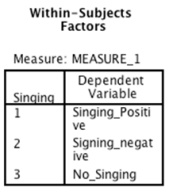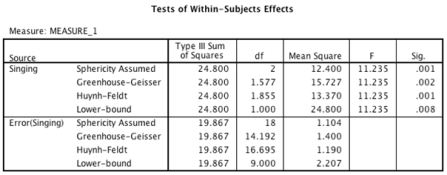Imagine we were interested in the effect of supporters singing on the number of goals scored by soccer teams. We took 10 groups of supporters of 10 different soccer teams and asked them to attend three home games, one at which they were instructed to sing in support of their team (e.g., 'Come on, you Reds!') , one at which they were instructed to sing negative songs towards the opposition (e.g., 'You're getting sacked in the morning!') and one at which they were instructed to sit quietly. The order of chanting was counterbalanced across groups.
-An ANOVA with a simple contrasts using the last category as a reference was conducted. Looking at the output tables below, which of the following sentences regarding the contrasts is correct?  Descriptive Statistics Number of goals scored when supporters sang songs of encouragement to their team Number of goals scored when supporters sang songs of abuse towards the opposition Number of goals scored when supporters sat quietly Mean 2.90.701.50 Std. Deviation 1.197.6751.080N101010
Descriptive Statistics Number of goals scored when supporters sang songs of encouragement to their team Number of goals scored when supporters sang songs of abuse towards the opposition Number of goals scored when supporters sat quietly Mean 2.90.701.50 Std. Deviation 1.197.6751.080N101010  Tests of Within-Subjects Contrasts
Tests of Within-Subjects Contrasts
Measure: MEASURE_1
Source Singing Error(Singing) Singing Level 1 vs. Level 3 Level 2 vs. Level 3 Level 1 vs. Level 3 Level 2 vs. Level 3 Type III Sum of Squares 19.6006.40024.4009.600 df 1199 Mean Square 19.6006.4002.7111.067 F 7.2306.000 Sig. .025.037
Conjunction
In logic, an operator that connects two statements or propositions so that the resulting statement is true only if both components are true.
Disjunction
A logical operation yielding a true value if at least one of its operands is true.
Conditional
A statement in logic that is compound and expresses a factual possibility or hypothetical situation and its consequence.
Biconditional
A logical connective indicating a statement in which two conditions are both necessary and sufficient for each other.

 Tests of Within-Subjects Contrasts
Tests of Within-Subjects Contrasts